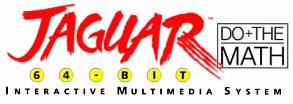|

It was the worlds first
64-Bit gaming console. It promised a quantum-leap in gaming
performance, and the world couldn't wait to get hold of one. Atari
was back with its first new console since the Atari 7800 which had been
released in 1986, could the company really take back the market it gave
birth too?
Jaguar was officially
launched in New York and San Francisco December 1993 - 27,000 units
moved in under 4 weeks. It was the start Atari had hoped for.
Over 150 developers had pledged support for the new Atari console and
IBM couldn't make enough Jaguar's to meet demand. Although systems
were selling, Atari had to step-up software development, the Jaguar
would be useless to the consumer unless there was software to support
it.

By the Summer of 1995, Atari
had sold over 150,000 units in the U.S. and over 60,000 in Europe and
the rest of the world.
But software releases were slow, and many titles simply weren't good
enough, they may have looked pretty, but gameplay was sadly lacking. A
number of "killer apps" were produced, such as Tempest 2000 and Alien
Vs. Predator - but where were all the other games that Atari had
promised? What happened to the 150 software developers who had
pledged support?
Before
launch, Atari was shipping custom TT systems and development kits - PC
development kits had been delayed, and this in turn delayed the
development companies, who refused TT systems! A Jaguar
Development system cost ~UKŁ5,000.00 (with TT030).

When the Jaguar was
released, it's only competition was ageing systems such as the original
8-bit Nintendo, the Super Nintendo (very successful 16-bit console), the
Mega Drive II from Sega (which was at the end of it's shelf life) and
the new, but expensive 3DO system. Other machines, such as the
Neo-Geo (SNK) and Turbo-Duo (NEC) were more or less Japanese only
systems.
Atari
had the head start which they felt would leap frog the on-coming
competition from Sega and Sony (Nintendo were another 2 years away from
launching their N64), unfortunately, 1994 was a year
wasted. Software was late; Atari pushed developers to launch
software, but the development time was the problem. Atari didn't
take development time into consideration with their new machine,
programmers were still getting to grips with the console, and Atari's
programming libraries were thin on the ground. By this time, Sony
had also delivered it's development systems, which in comparison to
Atari, were extremely comprehensive and came with the strong developer
support. Soon, as sales began to slow, developers moved
resources away from the Jaguar and onto Sega and Sony systems, which
were selling much better. Here lay Atari's big problem - software,
and the lack of it.
1995/96
- Although the Jaguar-CD unit was delivered (late), the gamers had
already been won over by Sega and Sony. Atari began talking about the
Jaguar-Duo (AKA Combo) and Jaguar II system, confusing and possibly eroding their
already small market. Atari kept fighting, shouting on the
roof-tops about the Jaguars "64-bit" architecture, cutting the
price point to $99.99, and even using the QVC home-shopping channel to
sell excess stock. Atari had cancelled its last outstanding
contract with Comptronix for new Jaguar units by mid 1995 (IBM's
contract was cancelled at the end of 1994). By the end of 1995,
Atari had over $10 Million worth of unsold stock.
The
Jaguar was (and still is) a fine piece of hardware, especially for the
price point, something Atari were well known for. But Jaguar was
the nail in the coffin for Atari Corp. Atari did try another
escape route to avoid total disaster, with the inception of Atari
Interactive, a business unit devoted to promoting Atari's back-catalogue
of famous software titles on the PC platform. Unfortunately, this
too was shelved after Tempest2000 launched in the stores, yet another
bad decision from management. Obviously Activision, Hasbro and
Infogrames think it's still a good idea (although the execution of some
of these products has been poor), and we still wait to see if the Atari
brand will ever rise from the ashes.
Hasbro (which purchased the leftovers of
Atari in 1998) released the platform into the public domain in 1999.
This means that anybody can develop and sell software for the Jaguar
without obtaining any official licensing from the copyright/property
holder.
|